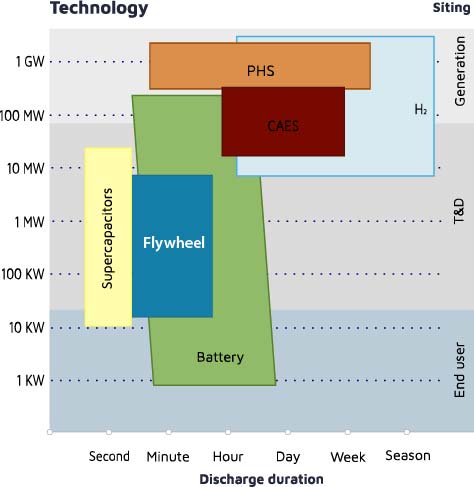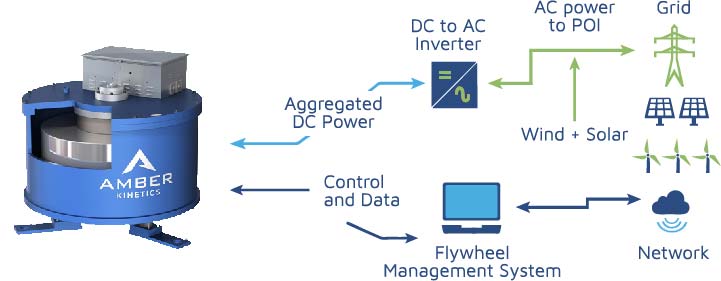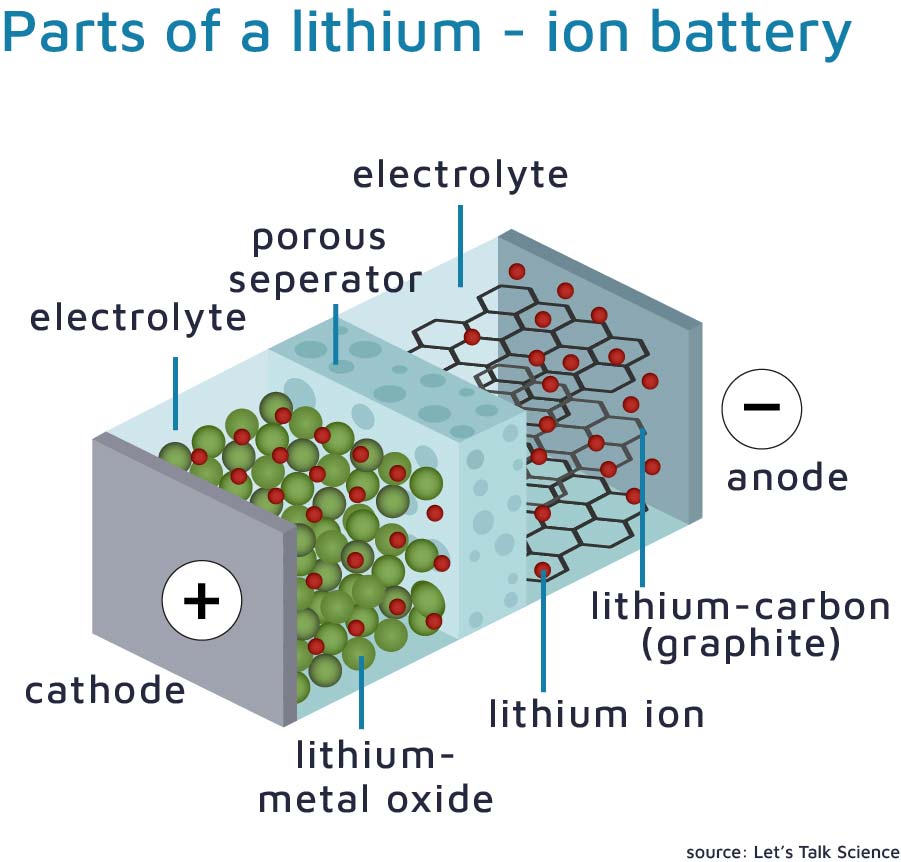Energy storage technologies
A key thing to understand about energy storage is that we essentially deal with two important variables: capacity and energy.
Capacity is how much electricity one gets at any given moment. It’s the same term we use for measuring demand or the output from a power plant, and it’s measured in terms of watts.
Typically, we see assets described in kilowatts (1,000 watts) or megawatts (one million watts). That’s the capacity side of the story. Just as relevant is the energy or the issue of duration. In other words: how much for how long, measured in kilowatt-hours or megawatt-hours. We might even get up to the next level of gigawatts and gigawatt-hours.
When we talk about storage, we get right into this discussion because the underlying storage technologies are usually better suited for supplying either capacity or energy, but not both. The following visual will help explain what we are talking about.
Image source: S&P Global
As one can see here, we are looking at magnitude on the Y axis. That is, how much power can I draw at any given time? On the X axis, we are observing duration.
This article will cover some of the technologies, including the once in the visual. We’ll first start with the shorter duration approaches and then move to more extended duration technologies.
Flywheels
Flywheels – are masses that spin in a vacuum, absorbing or releasing energy based on whether they accelerate or decelerate. As the rate of rotation increases, energy is absorbed from the grid. Likewise, as the rate decreases, energy is released.
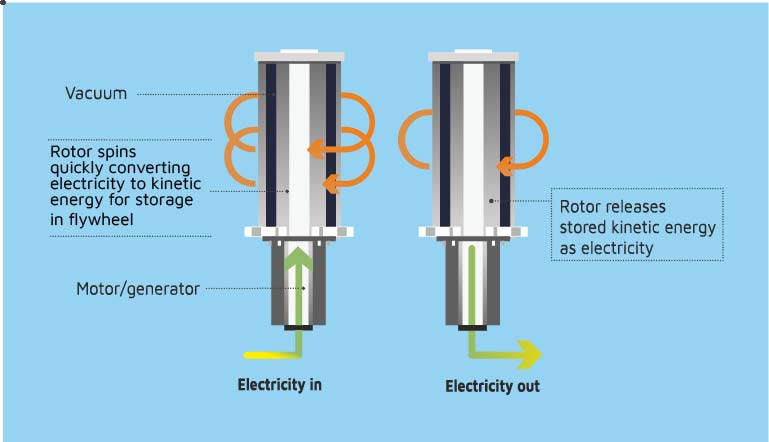
Image source: IESO
As one can see in the attached image, there is an oversight management software system and an inverter that converts AC power from the grid into the DC absorbed or released in the flywheel environment.
Image source: Amber Kinetics
Batteries
Batteries are next in line in their ability to quickly absorb or release energy and bring needed services such as reserves and capacity to the market. Batteries store energy as a result of a chemical reaction. If you discharge a battery, that reaction produces a flow of electrons. Charging the battery replenishes that energy.
The critical element of the battery is the cell in which a negative electrode (anode) and a positive electrode (cathode) are separated by an electrolyte and may also have a separator in the middle to regulate the flow of ions.
Positively charged ions flow from the anode into the electrolyte and over into the cathode, and a current is created.
Different chemistries in the battery anode and cathode result in different characteristics, and there are generally trade-offs between safety, cost, lifecycle, and other operating factors.
There are many battery types out there, including nickel metal hydride, nickel cadmium, and lead acid, but we will focus on the lithium ion family, which has its own variants.
Battery types:
Lithium ion batteries are very good at quickly absorbing or releasing energy and have fixed energy to capacity ratios. They are generally cost-effective for energy storage up to about four hours and make up the bulk of new energy storage deployed over the past few years. Still, a few other battery technologies are trying to compete, especially a few in the zinc family.
Zinc-based batteries can offer around eight hours of energy and are also relatively stable compared to lithium ion batteries. The other battery family that can provide eight or more hours duration is redox flow batteries. There are multiple variants of flow batteries, including vanadium-based chemistries and other less frequently employed variants such as iron chromium.
With flow batteries, one has an economy of scale in that the capacity – the amount you need at a given moment — is fixed by the size of the membrane in the middle between tanks of anolytes and catholytes (negatively and positively charged electrolytes). Flow batteries have slightly lower round trip efficiencies than lithium ion.
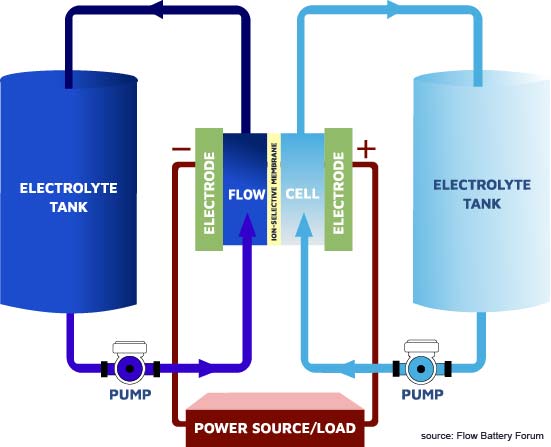
Storage technologies
From the flow batteries, we move to a series of storage technologies based on:
-elevation of weights
-thermal storage
-compression.
Most of these offer storage in the 8 to 12 hour range though some can go even longer, depending on the specific technology.
Weights
Let’s start with weights. It takes energy to raise weights, and lowering weights can release similar amounts of energy. Recently, we have seen companies moving into this area, like Advanced Rail Energy Storage (ARES), Gravitricity, EnergyVault.
Air technology
Let’s move to compressed air technologies. Compressors are used to pump air into underground storage caverns – either depleted gas reservoirs or salt domes at about 450 pounds per square inch. That compressed air is then released to spin a turbine or provide the pressurized air for a gas-fired turbine’s combustion process.
There is another variant out there that may be gaining traction, and that is a combination of compressed air and water. It uses a drilling and reservoir system and sends compressed air underground that displaces water in a purpose-built storage vessel, pushing water up a shaft into a closed reservoir. When power is required, the water pressure then drives air up the shaft into a turbine. Heat is captured in the compression process for efficiencies. 4-24 hours of duration and fast response services are provided, with a system life of up to 50 years.
In addition to storage utilizing air in various forms, several thermal storage applications use other media, including ice, hot rock, and a variety of molten technologies.
Coolant – using off-the-shelf technology, this technology uses electricity to compress air for storage in molten salts and cold antifreeze-type liquid. It then deploys a heat engine that runs on the differential temperatures. The energy from the salt, liquefied at 565 degrees °C, and coolant, stored at minus 60 degrees °C, would be converted back into electricity.
Molten aluminum is a technology that stores energy in molten aluminum at 600°C. That energy is then transferred via heat transfer fluid to a Stirling engine. The heat and cool gas 25 times per second cause expansion and contraction in the turbine.
Molten silicon technology stores energy from electricity or gas and offers heat and electricity. Energy from latent heat is recovered in the form of extremely hot air, which drives a turbine that produces heat and electricity as desired.
Other thermal applications are also out there as well, heating concrete, steel modules, sand, rocks, and other materials. None has as yet proved itself to be the hands-down winner, but it’s still early days.
Hydrogen – So what about long duration storage?
This technology will be needed as countries increasingly push to make their grids 100% carbon-free or close to it. The following illustrates the challenge and why long-term storage will be needed as we progress down that decarbonization path eventually.
This chart, from Berkeley University, depicts a future U.S. power grid that is 90% carbon free and assumes this could take place by 2035.

In such a scenario, a number of things are happening.
Let’s start at the top of the visual. The solid black line represents demand. The grey is curtailed energy, the light green is solar energy production, the darker green is wind energy, and the orange is discharged from batteries that occur every day to meet three or four hours of peak demand.
The light blue below is pumped hydro that offers energy storage; the dark blue is natural gas fired generation. Finally, below the gas are the steady nuclear plants that run 24 by 7 with constant output. And on the negative side of the line are the pumped hydro and battery storage assets that absorb energy at certain times of the day and release it at others.
The first thing one observes is that the green line is above the black line. That’s because, at certain times of the day, batteries and hydroelectric plants are absorbing power (with round-trip efficiency losses of 10% and 25 to 30%, respectively, each time they cycle). That energy is then released into the grid at other times of the day during peak demand, especially in the evenings when the sun goes down, even as demand is ramping up when people return to their homes.
The second thing one observes is that during the entire year, but in vastly varying amounts depending on the season, a substantial amount of electric energy – represented here in the grey color – gets curtailed.
All of that energy is from renewables. Some of it is underutilized because it’s expected to be so cheap to build new renewables – especially solar – that it will overproduce during the height of the day during the height of the season but still give us valuable energy during other times of the day or different times of the season to compensate for those losses. That is, it’s simply not used and thrown away, even though we can generate it.
There is no surplus and no curtailment during the peak demand season in North America during July through September. That’s because demand owing to air conditioning increases even as average wind generation output is less in the summer.
This leads us to the critical issue here from a decarbonization perspective: how to get rid of the natural gas-fired generation on the way to a 100% clean grid.
What can we do to eliminate the smaller blue bubble we see in the winter and the much larger one we see in the summer. Yes, gas is much cleaner than coal when it is burned in a turbine.
So the question becomes how to replace the gas-fired electric generation with something else at that kind of scale. Thus far, the only answer that appears feasible in terms of scale and duration is that simple gas molecule known as hydrogen. The theory is that we could as a society generate hydrogen from cheap renewables by applying a current and separating water into hydrogen and oxygen through a process known as electrolysis.
We know how to do this, and we have designed turbines to burn mixtures of hydrogen, methane, and even pure hydrogen, but there are some challenges with hydrogen in terms of costs and efficiency losses.
These efficiency losses are quite significant throughout the chain. Energy is lost in electrolysis, compressing or condensing the hydrogen, transporting and storing it, and then transforming it back into electricity using a turbine or fuel cell. Those losses are hard to eliminate as they result from fundamental physics, but at least the cost side of the equation can change.
These cost issues are starting to be addressed. There is a huge industrial push – with government support – to use abundant North Sea offshore wind, large resources of wind and solar in Australia, and some initial efforts in the United States.
To create affordable hydrogen, we will need to vastly reduce the costs of renewables, cut the costs of electrolyzers that generate the hydrogen, and come up with better and more cost-effective storage alternatives.

